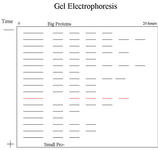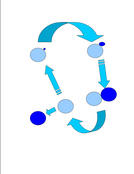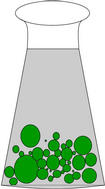Experiments Dealing with Cell Cycle
Experiments Regarding Cell Division
The following pictures are depictions of experiments dealing with the division of cells. Below them is an explanation of each.
Electrophoresis of Cyclin
The top picture shows a process called electrophoresis, which proves that cell division is dependent upon the presence of the protein cyclin. This is significant because it was the first time anyone discovered a macromoleule which outlined the process of cell division. The actual division points of the cell were correlated with the appearance and disappearance of the cyclin in intervals. The factor disappeared exactly when the cell began dividing, and reappered after division ended. The protein was named "cyclin", because its presence correlates with the cell cycle.
Budding Yeast Experiment
Maturation Promotion Factor
Dr. Masui looked at cyclin dependent kinase, which drives the cell cycle. This promotes protein phosphorylation, an event required for the cell to move from the G2 phase to mitosis. When this cyclin, or MPF, is injected into the oocytes, Masui discovered that they then divided at a rapid rate.



